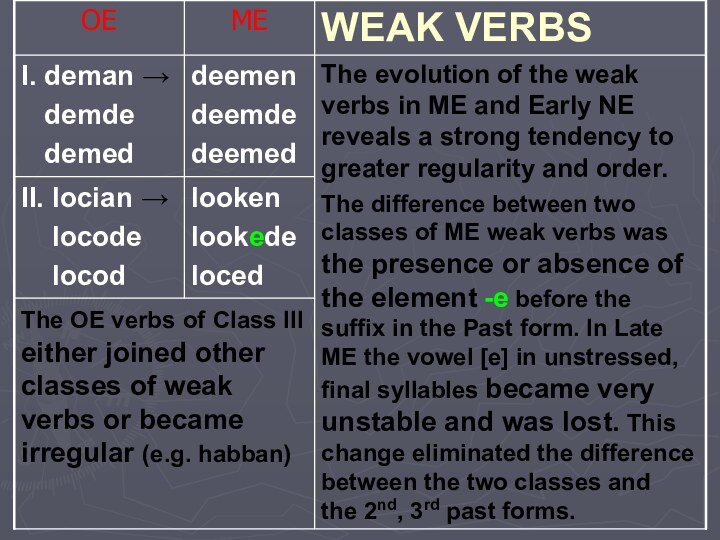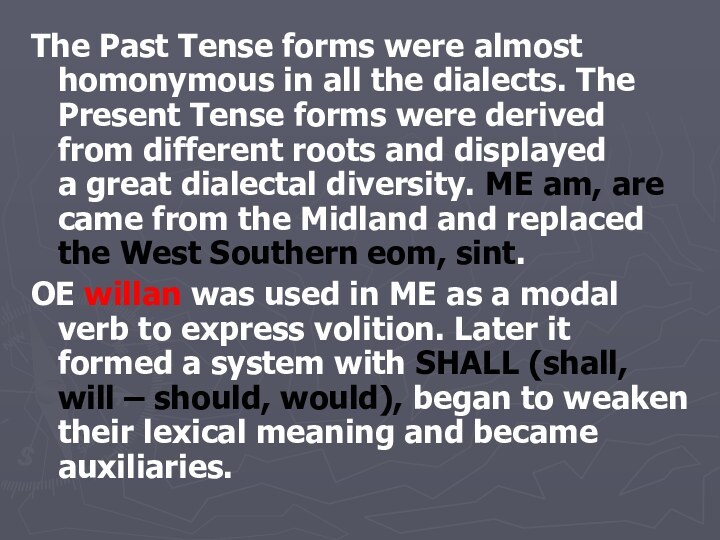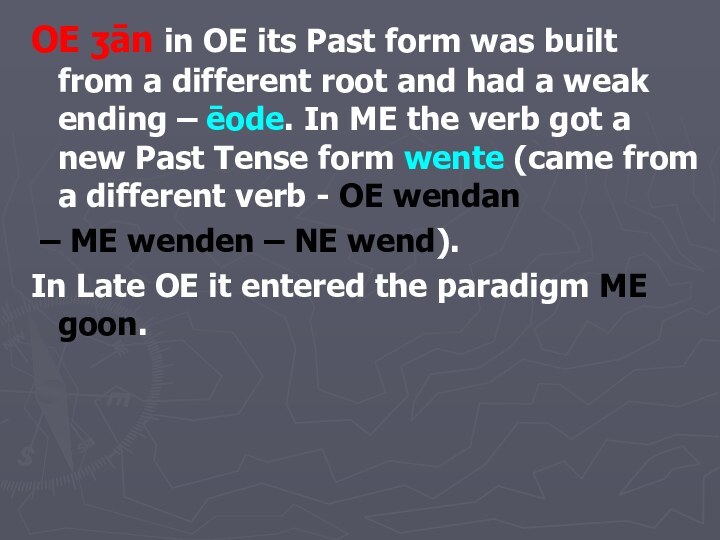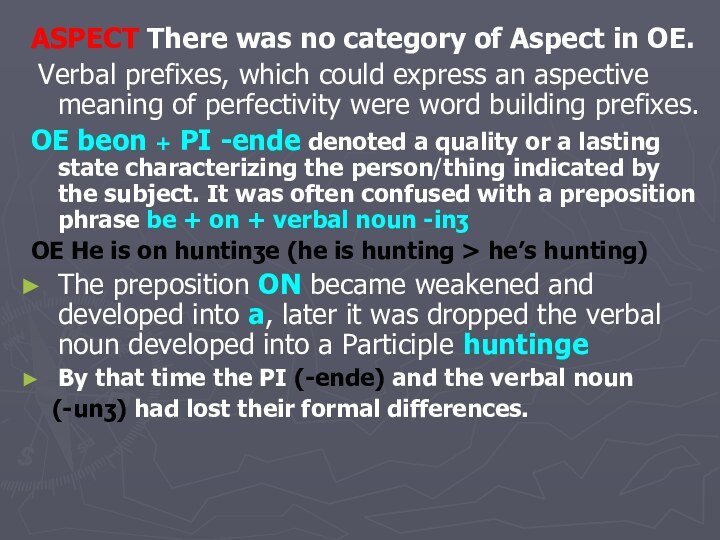Слайд 2
Plan
Development of the morphological classes of the verb
in ME.
1.1. Strong verbs
1.2. Weak verbs
1.3. Preterite-Present verbs
1.4. Irregular
verbs
2. Development of verbal grammatical categories.
Слайд 3
Literature
Расторгуева Т.А. История английского языка. – М.: Астрель,
2005. – С. 241-274.
Ильиш Б.А. История английского языка. –
Л.: Просвещение, 1972. – С. 189-204, 280-290.
Иванова И.П., Чахоян Л.П. История английского языка. – М.: Высшая школа, 1976. – С.156-190.
Студенець Г.І. Історія англійської мови в таблицях. - К.: КДЛУ, 1998. – Tables 78-81, 99-101
Слайд 4
Development of the morphological classes of the verb
in ME.
Unlike the morphology of the noun and adjective,
which have become much simpler.
The morphology of the verb displayed 2 tendencies:
Simplifying changes
(affected the synthetic forms);
The growth of new analytical forms +
new grammatical categories.
Слайд 5
Many markers of the grammatical forms of the
verb were reduced, leveled and lost in ME, ENE.
The reduction, leveling and loss of endings resulted in the neutralization of formal opposition and the growth of homonymy. ME forms of the verb
are represented
by numerous variants
which reflect
dialectal differences
and tendencies
of potential changes.
Слайд 6
STRONG VERBS
The historical changes in the ways of
building the basic forms of the verb transformed the
morphological classification of the verbs. The OE division into classes of strong/weak verbs was completely rearranged and broken.
Most verbs adopted the way of form-building used by the weak verbs (the dental suffix). The strict classification of the strong verbs with their regular system of form building deteriorated.
Слайд 9
In ME, ENE many strong verbs began to
form their Past and PII forms with the help
of dental suffixes. Therefore the number of strong verbs decreased and the number of weak verbs increased.
There were about 300 strong verbs in OE. Some of them dropped out of use because of the changes in vocabulary, most of the remaining verbs became weak. Out of 195 verbs (OE strong verbs) preserved in the language, only 67 have retained strong verbs with root vowel interchanges.
strong > weak : lock, grip, help, wash
weak > strong : wear, thrive, ring
(Comp. Modern German helfen – half - geholfen)
Слайд 12
Several preterite-present verbs went out of use. The
surviving verbs lost some of their old forms and
grammatical distinctions.
CAN (OE cunnan – cann – cunnon –cuðe - cunnen). The Past Tense Indefinite form appears in ME in two variants couthe – coulde, the only form coude was preserved in NE. The insertion of in spelling (could) was due to the analogy (should, would). In ME the verb CAN was still used in the original meaning “to know”.
Слайд 13
MAY (OE maʒan – mæʒ – maʒon –
meahte). Its infinitive and Participle
I went out of use. Some of its functions (indication of physical / mental ability) passed to the verb CAN.
SHALL (OE sceal) lost many old forms, retained only 2 forms shall, should. It was no longer used in ME as a notional verb, but as a modal verb (necessity, obligation).
ME MOT (the same meaning as CAN in NE)
(OE *motan – mōt – mōton - mōste) MOST
(the Past Tense form) has acquired the meaning of the present.
OUGHT developed from the OE āʒan (ah, aʒon, ahte, -) with the original meaning “to possess”
Слайд 14
Irregular verbs
They are verbs of high
text-frequency and great syntactic importance (most of them function
as auxiliaries).
ME BE(N). This was not really “a verb” in OE,
but a collection of semantically related paradigms of various historical origins. There are 3 major stems.
Слайд 15
The Past Tense forms were almost homonymous in
all the dialects. The Present Tense forms were derived
from different roots and displayed a great dialectal diversity. ME am, are came from the Midland and replaced the West Southern eom, sint.
OE willan was used in ME as a modal verb to express volition. Later it formed a system with SHALL (shall, will – should, would), began to weaken their lexical meaning and became auxiliaries.
Слайд 16
OE ʒān in OE its Past form was
built from a different root and had a weak
ending – ēode. In ME the verb got a new Past Tense form wente (came from a different verb - OE wendan
– ME wenden – NE wend).
In Late OE it entered the paradigm ME goon.
Слайд 17
Development of verbal grammatical categories
Слайд 18
TENSE There was no Future Tense in OE
(only Present and Past Tense). It was possible to
express future not only with the Present Tense form + special time indicators, but also with modal phrases (sculan, willan, magan, cunnan + infinitive).
In these phrases the meaning of future was combined with modal meaning of volition, obligation, possibility. In ME the use of modal phrases, especially with SHALL became common. SHALL + infinitive developed into the principal means of indicating future actions. Shall could retain its modal meaning of necessity, but often weakened it and expressed Future Tense. In the age of Shakespeare phrases with SHALL/WILL outnumbered all other ways of indicating future.
Слайд 19
MOOD In OE the forms of the Subjunctive
mood like other forms of the verb, were very
synthetic. In ME/NE a few analytical forms of the Subjunctive mood appeared.
In ME the formal distinctions between the Subjunctive and Indicative Moods were almost neutralized. OE Ind. Ic finde, hie findað – Subj. finde, finden
ME Ind. I finde, they finden – Subj. finde, finden.
Слайд 20
The increased homonymy of the forms
stimulated the more extensive use of modal verbs. Later
sholde / wolde outnumbered the other verbs.
ME sholde / wolde could weaken or lose their lexical meanings and turn into auxiliaries.
By the age of Shakespeare the change was complete the forms should/would (originally Past Subjunctive of shall/will) had become formal markers of the new, analytical forms of the Subjunctive mood.
A new function – to indicate Present and Future actions as imaginary or unreal.
Слайд 21
VOICE OE finite verbs had no category
of Voice. But there were some traces of the
Germanic Medio-Passive restricted to the verb hatan (to call). There was no regular opposition of forms in the verb paradigm.
In Late OE the constructions beon, wearthan + PII of transitive verbs were finally transformed into analytical forms of the Passive Voice.
In ME ben + PII could express not only a state but also an action.
The new Passive forms had a regular means of indicating the doer of the action/ instrument with the help of which the action was performed
OE mid, wi, bi - ME by, with
Слайд 22
TIME CORRELATION The main source of the Perfect
form was the OE “possessive” construction habban + direct
object + PII of a transitive verb, which served as an attribute to the object E.g. hie hine ofslæʒene hæfdon (they had them killed).
PII (like other attributes) agreed with noun objects in Number, Gender, Case in Early OE the verb habban was used only with PII of transitive and later with intransitive verbs.
Слайд 23
In the OE phrase beon + PII (of
intransitive verbs) the PII agreed with the Subject
OE
nu is se dæʒ cumen (Now is the day come = Now has the day come)
In Late OE the 2 phrases developed into analytical forms and made up a set of forms termed Perfect
The PII had lost its agreement with the noun (the Subject in the construction with ben, the object – haven)
The places of the object and the PII in the construction changed
In the Perfect form the auxiliary HAVE had lost the meaning of possession
Слайд 24
ASPECT There was no category of Aspect in
OE.
Verbal prefixes, which could express an aspective meaning
of perfectivity were word building prefixes.
OE beon + PI -ende denoted a quality or a lasting state characterizing the person/thing indicated by the subject. It was often confused with a preposition phrase be + on + verbal noun -inʒ
OE He is on huntinʒe (he is hunting > he’s hunting)
The preposition ON became weakened and developed into a, later it was dropped the verbal noun developed into a Participle huntinge
By that time the PI (-ende) and the verbal noun
(-unʒ) had lost their formal differences.
























